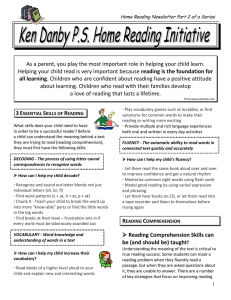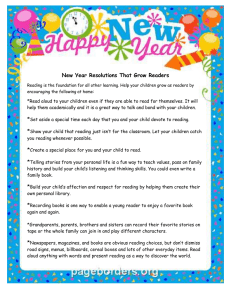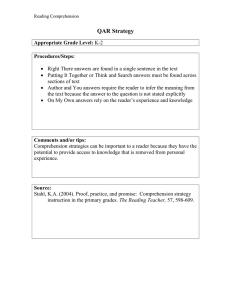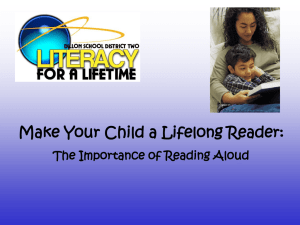Student Think Aloud – A Window into Readers` Thinking
advertisement
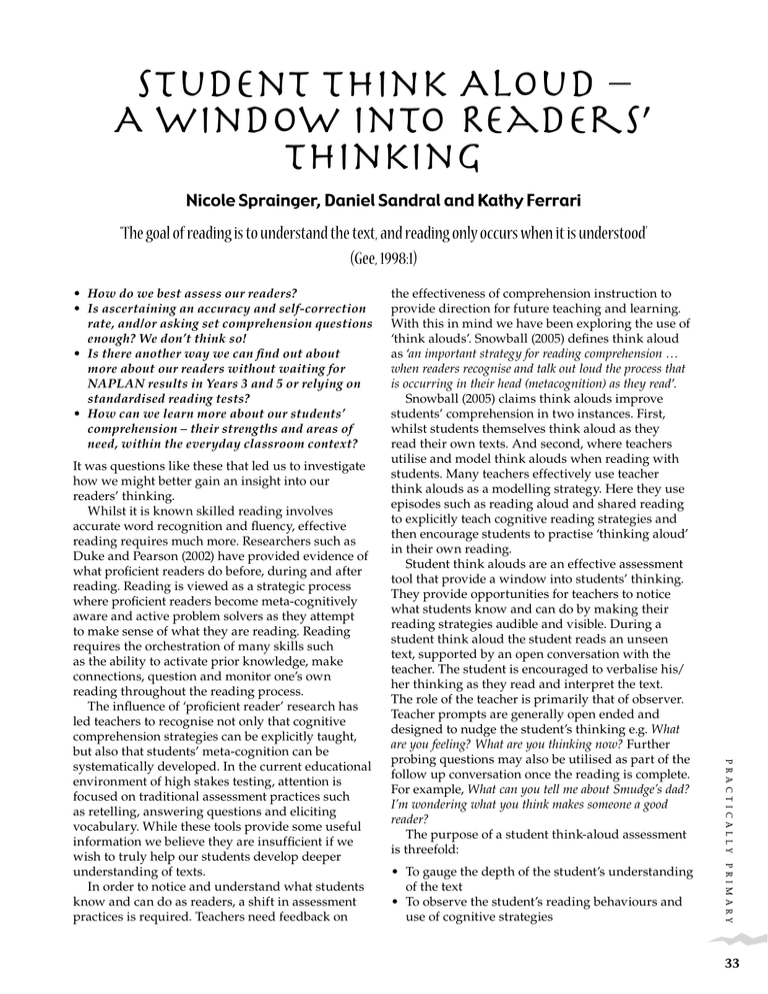
Student Think Aloud – A Window into Readers’ Thinking Nicole Sprainger, Daniel Sandral and Kathy Ferrari ‘The goal of reading is to understand the text, and reading only occurs when it is understood’ (Gee, 1998:1) • To gauge the depth of the student’s understanding of the text • To observe the student’s reading behaviours and use of cognitive strategies PRIM AR Y It was questions like these that led us to investigate how we might better gain an insight into our readers’ thinking. Whilst it is known skilled reading involves accurate word recognition and fluency, effective reading requires much more. Researchers such as Duke and Pearson (2002) have provided evidence of what proficient readers do before, during and after reading. Reading is viewed as a strategic process where proficient readers become meta-cognitively aware and active problem solvers as they attempt to make sense of what they are reading. Reading requires the orchestration of many skills such as the ability to activate prior knowledge, make connections, question and monitor one’s own reading throughout the reading process. The influence of ‘proficient reader’ research has led teachers to recognise not only that cognitive comprehension strategies can be explicitly taught, but also that students’ meta-cognition can be systematically developed. In the current educational environment of high stakes testing, attention is focused on traditional assessment practices such as retelling, answering questions and eliciting vocabulary. While these tools provide some useful information we believe they are insufficient if we wish to truly help our students develop deeper understanding of texts. In order to notice and understand what students know and can do as readers, a shift in assessment practices is required. Teachers need feedback on the effectiveness of comprehension instruction to provide direction for future teaching and learning. With this in mind we have been exploring the use of ‘think alouds’. Snowball (2005) defines think aloud as ‘an important strategy for reading comprehension … when readers recognise and talk out loud the process that is occurring in their head (metacognition) as they read’. Snowball (2005) claims think alouds improve students’ comprehension in two instances. First, whilst students themselves think aloud as they read their own texts. And second, where teachers utilise and model think alouds when reading with students. Many teachers effectively use teacher think alouds as a modelling strategy. Here they use episodes such as reading aloud and shared reading to explicitly teach cognitive reading strategies and then encourage students to practise ‘thinking aloud’ in their own reading. Student think alouds are an effective assessment tool that provide a window into students’ thinking. They provide opportunities for teachers to notice what students know and can do by making their reading strategies audible and visible. During a student think aloud the student reads an unseen text, supported by an open conversation with the teacher. The student is encouraged to verbalise his/ her thinking as they read and interpret the text. The role of the teacher is primarily that of observer. Teacher prompts are generally open ended and designed to nudge the student’s thinking e.g. What are you feeling? What are you thinking now? Further probing questions may also be utilised as part of the follow up conversation once the reading is complete. For example, What can you tell me about Smudge’s dad? I’m wondering what you think makes someone a good reader? The purpose of a student think-aloud assessment is threefold: P RA C T IC A LLY • How do we best assess our readers? • Is ascertaining an accuracy and self-correction rate, and/or asking set comprehension questions enough? We don’t think so! • Is there another way we can find out about more about our readers without waiting for NAPLAN results in Years 3 and 5 or relying on standardised reading tests? • How can we learn more about our students’ comprehension – their strengths and areas of need, within the everyday classroom context? 33 • To determine the extent of their metacognition, that is, their conscious awareness of sense making strategies and how these help them as a reader It may also provide valuable feedback about: • The effectiveness of reading comprehension instruction • Reader motivation and engagement, as well as • How the student perceives themself as a reader VOLU M E 16 N UM B ER 1 F E BR U ARY 20 11 By engaging in several student think aloud assessment conversations over time, with a variety of authentic texts, teachers can gain additional feedback. Teachers may gain insights into a student’s ability to be a flexible strategic reader, who can vary their reading strategies to fit the text genre or context. The information the teacher gains from a student think aloud is quite different from that emerging from the analysis of traditional skillsbased assessments such as NAPLAN, cloze passages or simple retellings. It is invaluable in planning for ongoing teaching and learning in the reading program. The use of student think aloud as an assessment tool is now illustrated in the following case studies. 34 Student Think Aloud Case Study 1: Bella Bella is a Year 6 student from a low SES, multicultural, comprehensive primary school located in Sydney’s inner western suburbs. Bella’s teachers had been recently introduced think aloud during shared reading. Bella was asked to ‘think aloud’ as she read an unseen text, The Tunnel by Anthony Browne. Bella’s responses (some which are provided below) provided her teacher with feedback about Bella as a reader, including her ability to make sense of the text and insights into her development of metacognitive reading behaviours. These rich data also provided evidence of the effectiveness of the instructional reading program thus far. The full video of Bella’s Think Aloud can be found at http://au.myspace.com/video/557108920/thinkaloud/107174588 Bella’s comprehension of text Listening to Bella’s think aloud and subsequent conversation reveals she clearly comprehended the text, and made use of some of the cognitive strategies that support comprehension: • Bella used the pictures to help shape her predictions and understand the characters more deeply – ‘she likes fairytales like Little Red Riding Hood, Sleeping Beauty and all different characters and he [the brother] looks a bit like Fox (from Margaret Wild’s book of the same name); she just can’t let go of her books; I noticed as he changed, the background got brighter…it’s not dark and weary anymore’ • She made lots of connections to characters from other books and texts from similar genres – ‘she looks a little bit like Red Riding Hood; when it said it was a dark and scary night I thought a bit of Snow White and how she’s running away…and the woods look a bit scary, plus the axe looks like the hunter – how he’s trying to get her heart’ • While reading she uses her prior knowledge of Greek mythology to help her relate to characters – ‘I was going to relate this to a Greek story – how she has the snakes coming out of her head – like whenever someone looks at her, she turns them into stone’ • She could draw out some understanding of theme – ‘[Anthony Browne’s message is] that differences don’t really matter but at the end differences can be really good and make good friendships’ These observations demonstrate the ability to make connections between characters in an unseen text and those she has read about before. Her identification of the story’s theme also demonstrates the ability to connect to her own experiences. However, missing in her think aloud was an understanding of the ways that authors position readers. Bella’s think aloud and the subsequent conversation points to the need for her to learn more about how authors craft a text. Bella would benefit from learning experiences focused on positioning, for example, the ways that authors deliberately tell the story from a particular character’s point of view in order to evoke empathy for a character. Bella was unable to do this. Bella’s metacognition – comments on her own behaviours as a reader In terms of Bella’s awareness of herself as a reader, she reports as sometimes being a good reader. She is aware of some of the cognitive strategies that she uses – ‘I was able to connect and visualize these stories and connect this story to other stories…I was also thinking about what would happen next and saying my opinion of this book’. These comments demonstrate some initial development of Bella’s meta-comprehension. This could be considered a consequence of Bella’s teacher using think aloud during recent shared reading experiences. Student Think Aloud Case Study 2: Emily During the reading and in the post reading discussion, Emily demonstrated a clear understanding of the text. • She confidently discussed relationships between text and illustrations and noticed significant details such as clothing and fonts used for various characters. • Emily showed a strong sense of characterisation. She identified individual personality traits; e.g. Smudge ‘She’s a cheerful animal’; Mum ‘posh’; Dad ‘he’s a worn person’. She also clearly identified with Smudge ‘I reckon Smudge is great. That’s how I’d dress!’ and empathised with Charles.’ I wouldn’t like to be in his shoes!’ She also infers characters’ motivations for behaving in particular ways e.g. describing Mum as being ‘worried about what others think’; and having a ‘pedigree Labrador’. • She discussed many other text aspects including storyline and identified broad themes including friendship; Charles’ loneliness; parent-child relationships. • Emily was also prepared to grapple with ambiguity and try to resolve uncertainty particularly in relation to the question about how many visits to the park, finally reflecting that it was one visit and ‘The voices were different people’s point of view.’ • Finally she demonstrated considerable insights into Anthony Browne’s style and compared it to the ‘creativity’ of other authors and/or illustrators such as ‘Margaret Wild’. It is interesting to consider the different ways this substantial knowledge and advanced ability to flexibly apply strategies has developed. Emily demonstrates a complex reading system that would support her in a range of ways both in the classroom and beyond. Her exposure to a range of quality picture books, especially a collection from the same author could be an important support in the development of this sophisticated knowledge. Emily’s metacognition – comments on her own behaviours as a reader PR IM AR Y • Emily considers herself a good reader. She recognises reading is a process which involves thinking ‘it helps your brain be more creative’. She also made lots of references to reading being the capacity to read hard words. • She knows reading helps her to: know about the world; acquire new vocabulary; even spell difficult words e.g. ‘sophisticated’ • In terms of making sense of text she described a range of fix-up strategies such as ‘slowing down’ ‘rereading’ and ‘reading-on’ PR AC T ICA LLY Emily is a Year 4 student from an English Speaking Background who attends a comprehensive primary school in Western Sydney. Emily is a confident and capable reader, reading above grade expectations. She has had limited exposure to explicit teaching about comprehension strategies. In this think aloud experience and conversation, she was reading an unseen text, Voices in the Park by Anthony Browne. She had however previously read Gorilla and Piggybook also authored by Anthony Browne. The full transcript is available at http://www.slideshare. net/nsprainger/think-aloud-conversation-withemily-6035681 Emily’s comprehension of text 35 • Emily also was able to identify visualisation as helping her as a reader e.g. ‘using pictures’ to help in understanding story in picture books and ‘making pictures in your mind’ when pictures are absent. • She speculates – predicts and questions freely and ‘out loud’ e.g. ‘I still don’t understand why he has man arms!’ • She makes connections – to authors’ styles and other texts and how they help her as a reader The cases of Bella and Emily provide important information as we consider the value of think alouds for assessment. The cases demonstrate that each student has different strengths in terms of their reading comprehension, and at this stage Emily’s metacomprehension is more sophisticated than Bella’s. Both examples offer a window into these students’ thinking and provide specific insights for the next steps required for their learning. For us, this is evidence that student think alouds are a worthwhile assessment tool, and therefore something we will continue to utilise. VOLU M E 16 N UM B ER 1 F E BR U ARY 20 11 Benefits of the Student Think Aloud as an assessment tool 36 • It can be done anywhere, anytime with any text (like a running record) • Natural conversation flows as students have a point of reference (the text) • The oral nature does not disadvantage those who are less familiar with pencil and paper tests or ESL students where the language of questioning can sometimes inhibit responses • As with numeracy interviews students are encouraged to justify their thinking and elaborate • You can potentially learn far more about a student and how they process than from traditional testing • The tool provides information not readily available on standardised tests Strategy Index (MSI) instrument, (Schmitt, 1990) – a multiple-choice questionnaire which asks students about strategies that might be used before, during and after reading a narrative selection? • Is it worth devoting time to this for every student, like we would for Numeracy Assessment Interviews? Some teaching possibilities/considerations • Teacher think alouds during episodes such as shared reading and reading aloud • Jointly constructed Anchor Charts focusing on cognitive strategies used by effective readers • Oral sharing, practice & reflection e.g. Turn and Talk; Say Something (Hoyt, 2009) • Student journals – students can self-assess and set goals for themselves • Students could film themselves reading and then record comments using webcam/flip video • Reading conferences References Duke, N.K. & Pearson, P.D. (2002). Effective Practices for Developing Reading Comprehension. In A.E. Farstrup & S.J. Samuels (Eds.), What Research has to say about Reading, Third Edition. (pp. 205–242). International Reading Association, Inc. Gee, H. (1998). Metacomprehension strategies: Help for struggling readers. PEN 112. Marrickville. NSW: Primary English Teachers Association. Hoyt, L. (2009). Revisit, Reflect, Retell: Time-Tested Strategies for Teaching Reading Comprehension. Portsmouth: Heinemann. Schmitt, M.C. (1990). ‘A questionnaire to measure children’s awareness of strategic reading processes’, The Reading Teacher, 43(7), 454–61. Snowball, D. (2005). Teaching Comprehension: An interactive professional development course. 3–6. Port Washington, N.Y. Aussie Interactive. Wade, S.E. (1990). Using Think Alouds to Assess Comprehension. The Reading Teacher, 43(7), 442–451. Questions we still want to further explore • Should the student read the text itself silently or aloud? • Should we be using the same text for all children so comparisons can be made? • Do we need standardised measures by which to compare student thoughts e.g. a literacy continuum or rubric? • Do we need to try several think alouds using different genres or at different levels of difficulty to get a true picture of the student as a reader? • Could this strategy be incorporated into guided sessions and/or independent reading conferences? • Would the results be similar if using ‘self-report’ assessments such as the The Metacomprehension Nicole, Daniel and Kathy have been working as Teaching Educators for the Catholic Education Office in the Diocese of Parramatta for the past three years. A major part of their role has been to work alongside teachers in classrooms and with school leadership teams to improve the literacy outcomes for students in Catholic schools in western Sydney, particularly in the area of reading comprehension.
